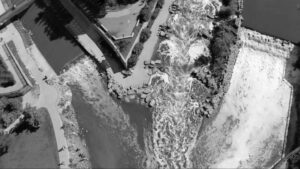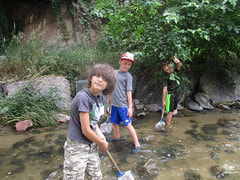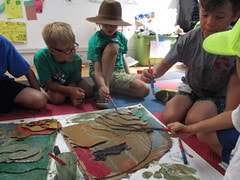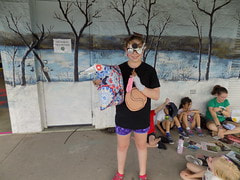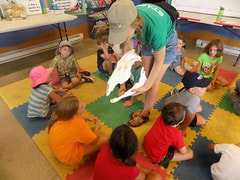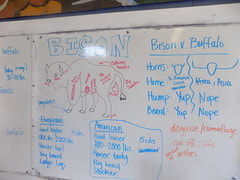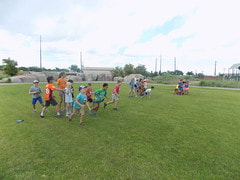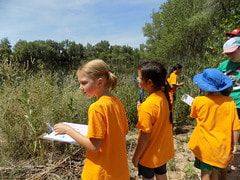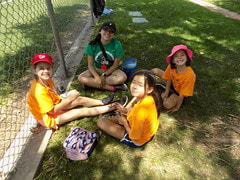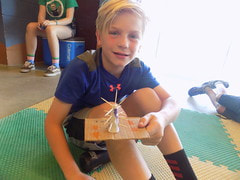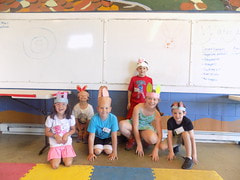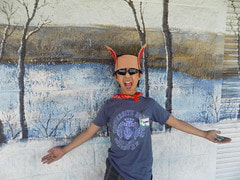This week at SPREE camp, campers followed a drop of water through the water systems of Colorado as it flowed through streams, waited in reservoirs, traveled across mountains, got cleaned in treatment plants, used in homes, and went down drains.
Monday: Where does our water come from?
All of our water in Denver comes from snow melt in the mountains! Campers started off their week at camp investigating how a watershed works through activities, building models, and conducting experiments.
Next, campers discovered how the water in our waterways in Colorado connect to others throughout the country- and even to the ocean! We analyzed maps, made our bodies into a map of some major US rivers, and then got into the creek to discover what the one of Denver’s waterways looks like first hand!
We wrapped up our day by starting off our all-camp collaborative 3-D model of a waterway’s journey through many different landscapes it goes through in Colorado. We started with big features like the river flowing down mountains and between buildings today!
Monday: Where does our water come from?
All of our water in Denver comes from snow melt in the mountains! Campers started off their week at camp investigating how a watershed works through activities, building models, and conducting experiments.
Next, campers discovered how the water in our waterways in Colorado connect to others throughout the country- and even to the ocean! We analyzed maps, made our bodies into a map of some major US rivers, and then got into the creek to discover what the one of Denver’s waterways looks like first hand!
We wrapped up our day by starting off our all-camp collaborative 3-D model of a waterway’s journey through many different landscapes it goes through in Colorado. We started with big features like the river flowing down mountains and between buildings today!
Tuesday: Forests
Today, campers learned how the rivers are connected to Colorado forests. An obvious connection is that they flow through forests! We learned many other cool facts: forests help filter and clean water, help prevent floods, and help keep the water fresh and cool with shade for the aquatic animals.
We also learned about many forest-dwelling animals! First, campers learned about some awesome forest animals- black bears! We learned about their many cool adaptations through a dress up activity, a bear foraging game, and bear “musical chairs” that was limited by resources and food that bears need.
Then, we learned about a pair of similar Colorado animals- lynx and bobcats! We studied their similarities and differences, learned about big cat hunting and survival adaptations, and practiced hunting like a lynx!
Another forest animal we learned about were Elk! We got to investigate some of their bio clues: pelt, skull, hoof, and scat, and then played a game where we had to remove our “velvet” off our arm antlers with the help of a tree!
Today, campers learned how the rivers are connected to Colorado forests. An obvious connection is that they flow through forests! We learned many other cool facts: forests help filter and clean water, help prevent floods, and help keep the water fresh and cool with shade for the aquatic animals.
We also learned about many forest-dwelling animals! First, campers learned about some awesome forest animals- black bears! We learned about their many cool adaptations through a dress up activity, a bear foraging game, and bear “musical chairs” that was limited by resources and food that bears need.
Then, we learned about a pair of similar Colorado animals- lynx and bobcats! We studied their similarities and differences, learned about big cat hunting and survival adaptations, and practiced hunting like a lynx!
Another forest animal we learned about were Elk! We got to investigate some of their bio clues: pelt, skull, hoof, and scat, and then played a game where we had to remove our “velvet” off our arm antlers with the help of a tree!
Wednesday: Prairies
Another cool Colorado ecosystem is a prairie! Prairies are a unique type of grassland found in North America- including Colorado.
Campers learned about unique features of prairies- including the types of plants, types of soils, types of weather and amounts of precipitation, and types of animals that live there. Campers delved into prairie plant adaptations with a dress up and drawing activity: they have skinny leaves to minimize water loss, super long roots to collect water, ability to grow back after fires, ability to grow back after being eaten by grazers, and more! Campers then went on a mini plant exploration hike to discover that Denver is actually built on prairie land!
Next, we learned about a few Colorado Prairie animals!
We played a game to learn about how all parts of the bison were used by Arapahoe and Cheyenne tribes, tried to lift how much bison eat in a day (24 pounds!), and played a hunting game to reenact some Native American skills.
Another animal we learned about was a prairie dog! Campers learned how they are a keystone prairie species, and we played a game to learn how they communicate danger, “yip, yip!”
And as always, we got time to explore the river, cool off, and catch some critters.
Another cool Colorado ecosystem is a prairie! Prairies are a unique type of grassland found in North America- including Colorado.
Campers learned about unique features of prairies- including the types of plants, types of soils, types of weather and amounts of precipitation, and types of animals that live there. Campers delved into prairie plant adaptations with a dress up and drawing activity: they have skinny leaves to minimize water loss, super long roots to collect water, ability to grow back after fires, ability to grow back after being eaten by grazers, and more! Campers then went on a mini plant exploration hike to discover that Denver is actually built on prairie land!
Next, we learned about a few Colorado Prairie animals!
We played a game to learn about how all parts of the bison were used by Arapahoe and Cheyenne tribes, tried to lift how much bison eat in a day (24 pounds!), and played a hunting game to reenact some Native American skills.
Another animal we learned about was a prairie dog! Campers learned how they are a keystone prairie species, and we played a game to learn how they communicate danger, “yip, yip!”
And as always, we got time to explore the river, cool off, and catch some critters.
Thursday: The City (Field Day)
Another important Colorado ecosystem that the river flows through is cities! Many plants and animals inhabit this urban landscape, even if it may not be obvious at first! Campers took a short hike along the river trail to nearby Vanderbilt park. We learned about squirrels through an animal mystery activity and a predator and prey game. Then, we explored in the tall grasses and discovered many exciting parts of nature in the city while on a scavenger hunt!
Another important Colorado ecosystem that the river flows through is cities! Many plants and animals inhabit this urban landscape, even if it may not be obvious at first! Campers took a short hike along the river trail to nearby Vanderbilt park. We learned about squirrels through an animal mystery activity and a predator and prey game. Then, we explored in the tall grasses and discovered many exciting parts of nature in the city while on a scavenger hunt!
Friday: Desert
Colorado has some desert regions in it, too! With very little rain, plants and animals have many cool and unique adaptations to survive the tough conditions.
We discussed a few types of desert plants with unique adaptations, but of course we primarily focused on cactus! Campers made model cactus out of clay to see that their spines are not only a defense mechanism, but they also provide shade for the plants! Next, we got to dissect a prickly pear cactus leaf to see what they look like inside where all their water and nutrients are stored.
Jackrabbits and roadrunners were some cool desert animals that campers got to learn about! We made our own jackrabbit ears while we learned about their unique cooling system. Then, we learned some cool roadrunner facts and played a game to learn about their speed and hunting skills!
Before critter crawl, we discussed how deserts typically don’t have waterways running through them and what some environmental desert dangers could be (and how to help avoid them!) Then we got to get in the creek to cool off after our “heated” discussion!
Now that the campers were Colorado ecosystem experts, we wrapped up our week with a graduation ceremony!
Colorado has some desert regions in it, too! With very little rain, plants and animals have many cool and unique adaptations to survive the tough conditions.
We discussed a few types of desert plants with unique adaptations, but of course we primarily focused on cactus! Campers made model cactus out of clay to see that their spines are not only a defense mechanism, but they also provide shade for the plants! Next, we got to dissect a prickly pear cactus leaf to see what they look like inside where all their water and nutrients are stored.
Jackrabbits and roadrunners were some cool desert animals that campers got to learn about! We made our own jackrabbit ears while we learned about their unique cooling system. Then, we learned some cool roadrunner facts and played a game to learn about their speed and hunting skills!
Before critter crawl, we discussed how deserts typically don’t have waterways running through them and what some environmental desert dangers could be (and how to help avoid them!) Then we got to get in the creek to cool off after our “heated” discussion!
Now that the campers were Colorado ecosystem experts, we wrapped up our week with a graduation ceremony!

